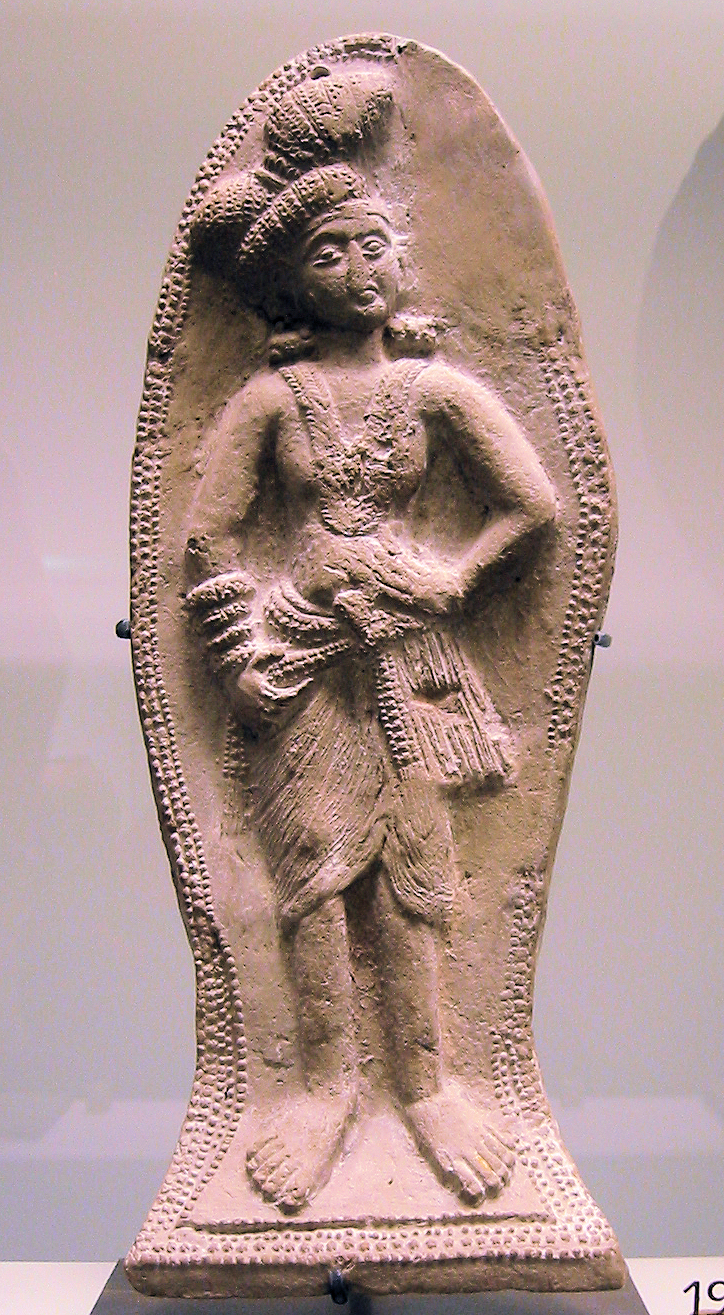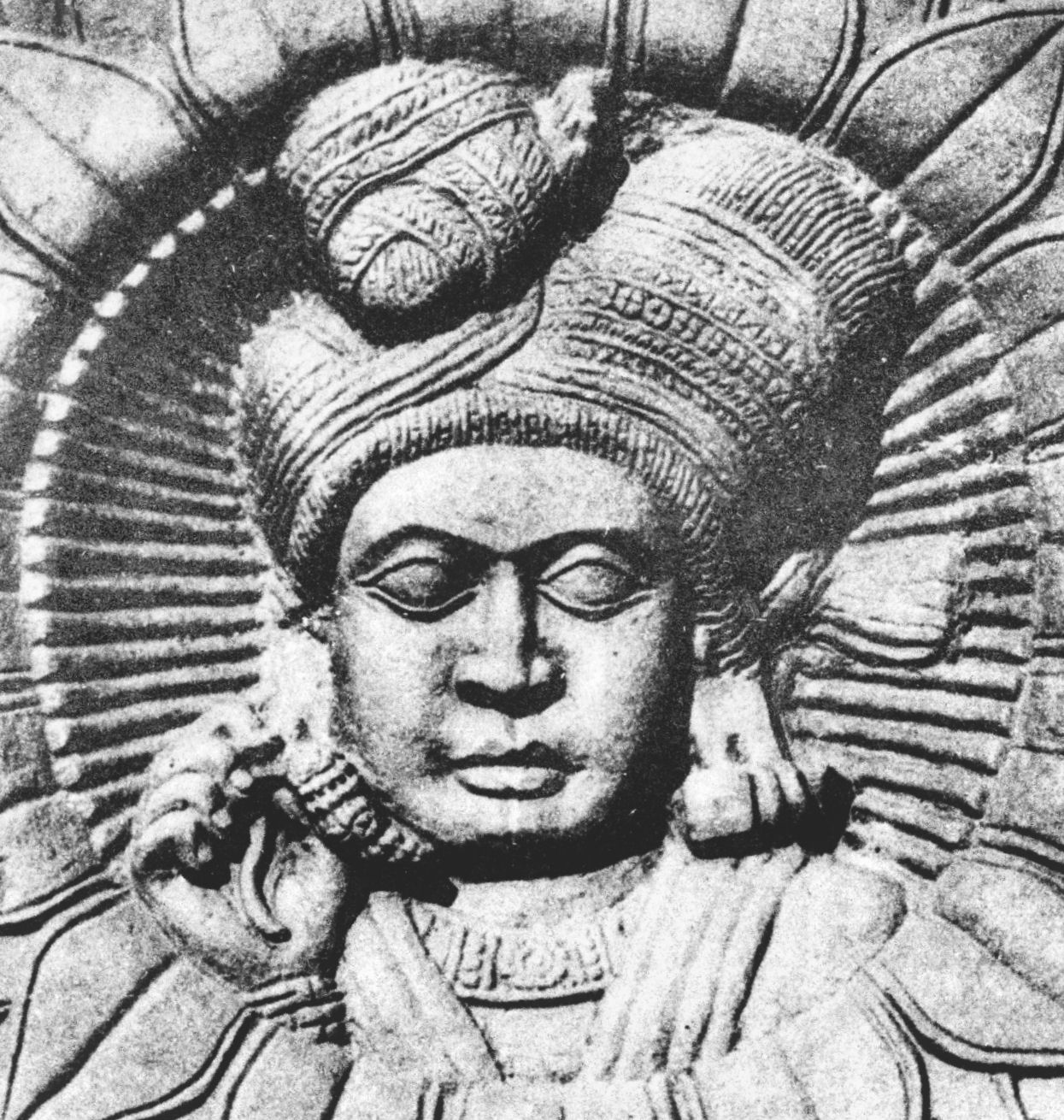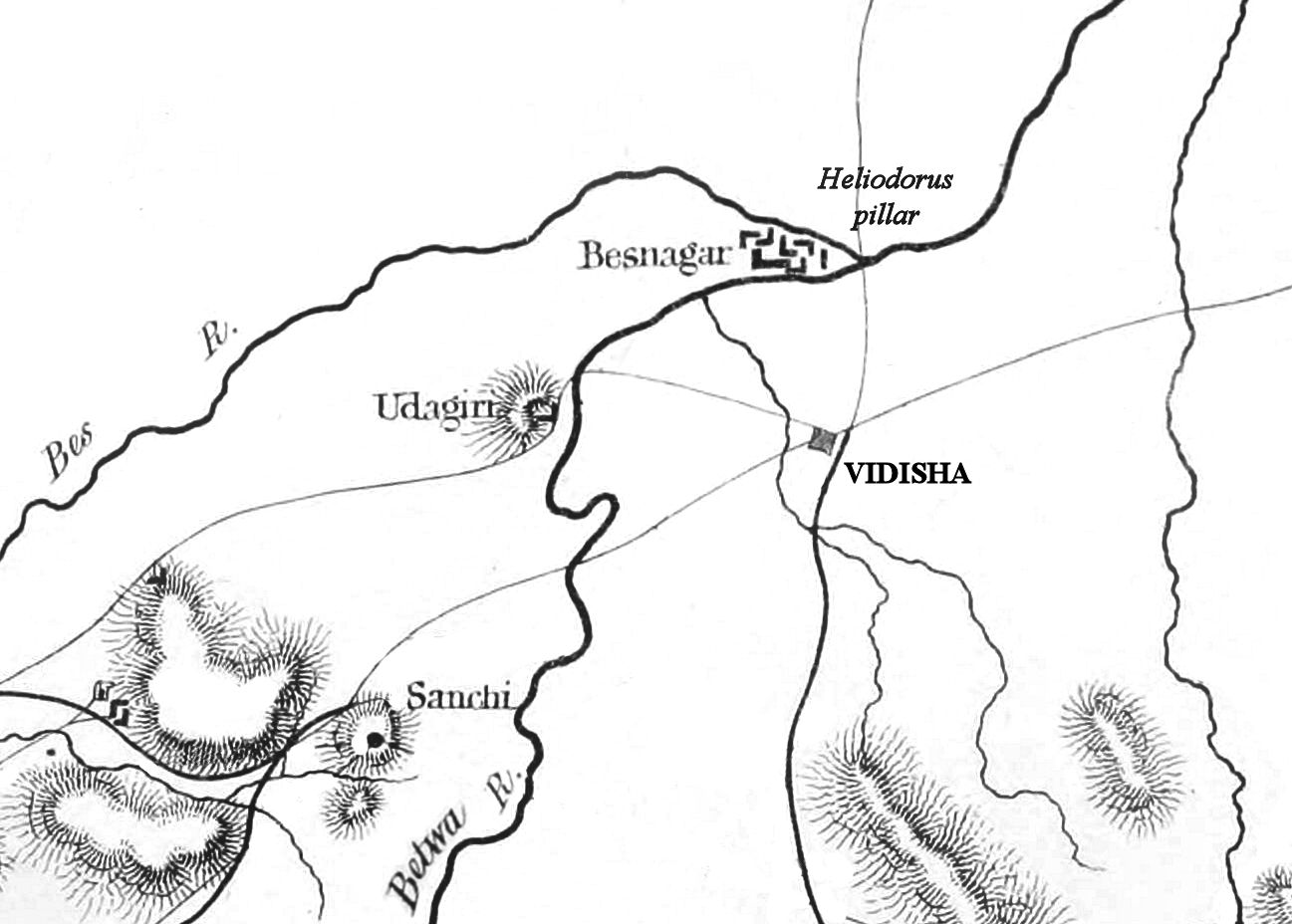|
Bhagabhadra
Bhagabhadra (Brāhmī: 𑀪𑀸𑀕𑀪𑀤𑁆𑀭 , ) was one of the kings of the Indian Shunga dynasty. He ruled in north, central India around from 114 BCE to 83 BCE. Although the capital of the Shungas was at Pataliputra, he was also known to have held court at Vidisha. It is thought that the name Bhagabhadra also appears in the regnal lists of the Shungas in the Puranic records, under the name Bhadraka, fifth ruler of the Shungas. Heliodorus inscription He is best known from an inscription at the site of Vidisha in central India, the Heliodorus pillar, in which contacts with an embassy from the Indo-Greek king Antialcidas is recorded, and where he is named "Kasiputra Bhagabhadra, the Saviour, son of the princess from Benares": Translation: :(Archaeological Survey of India, Annual Report (1908-1909)) This inscription is important in that it tends to validate that the Shungas ruled in the area of Vidisa around 100 BCE. This is also corroborated by some artistic realizat ... [...More Info...] [...Related Items...] OR: [Wikipedia] [Google] [Baidu] |
Heliodorus Pillar
The Heliodorus pillar is a stone column that was erected around 113 BCE in central India in Besnagar (near Vidisha, Madhya Pradesh). The pillar was called the ''Garuda-standard'' by Heliodorus, referring to the deity Garuda. The pillar is commonly named after Heliodorus, who was an ambassador of the Indo-Greek king Antialcidas from Taxila, and was sent to the Indian ruler Bhagabhadra. A dedication written in Brahmi script was inscribed on the pillar, venerating Vāsudeva, the ''Deva deva'' the "God of Gods" and the Supreme Deity.''Devadeva'', the "God of Gods", the Supreme Deity in The pillar also glorifies the Indian ruler as "Bhagabhadra the savior". The pillar is a stambha which symbolizes joining earth, space and heaven, and is thought to connote the "cosmic axis" and express the cosmic totality of the Deity. The Heliodorus pillar site is located near the confluence of two rivers, about northeast from Bhopal, from the Buddhist stupa of Sanchi, and from the Hindu Udayagir ... [...More Info...] [...Related Items...] OR: [Wikipedia] [Google] [Baidu] |
Shunga Empire
The Shunga Empire (IAST: ') was an ancient Indian dynasty from Magadha that controlled areas of the most of the northern Indian subcontinent from around 185 to 73 BCE. The dynasty was established by Pushyamitra Shunga, Pushyamitra, after taking the throne of the Maurya Empire. Its capital was Pataliputra, but later emperors such as Bhagabhadra also held court at Besnagar (modern Vidisha) in eastern Malwa. Pushyamitra ruled for 36 years and was succeeded by his son Agnimitra. There were ten Shunga rulers. However, after the death of Agnimitra, the second king of the dynasty, the empire rapidly disintegrated:K.A. Nilkantha Shastri (1970)''A Comprehensive History of India: Volume 2'' p.108: "Soon after Agnimitra there was no 'Sunga empire'." inscriptions and coins indicate that much of northern and central India consisted of small kingdoms and city-states that were independent of any Shunga hegemony.Bhandare, Shailendra. "Numismatics and History: The Maurya-Gupta Interlude in the G ... [...More Info...] [...Related Items...] OR: [Wikipedia] [Google] [Baidu] |
Shunga Dynasty
The Shunga Empire (IAST: ') was an ancient Indian dynasty from Magadha that controlled areas of the most of the northern Indian subcontinent from around 185 to 73 BCE. The dynasty was established by Pushyamitra, after taking the throne of the Maurya Empire. Its capital was Pataliputra, but later emperors such as Bhagabhadra also held court at Besnagar (modern Vidisha) in eastern Malwa. Pushyamitra ruled for 36 years and was succeeded by his son Agnimitra. There were ten Shunga rulers. However, after the death of Agnimitra, the second king of the dynasty, the empire rapidly disintegrated:K.A. Nilkantha Shastri (1970)''A Comprehensive History of India: Volume 2'' p.108: "Soon after Agnimitra there was no 'Sunga empire'." inscriptions and coins indicate that much of northern and central India consisted of small kingdoms and city-states that were independent of any Shunga hegemony.Bhandare, Shailendra. "Numismatics and History: The Maurya-Gupta Interlude in the Gangetic Plain". i' ... [...More Info...] [...Related Items...] OR: [Wikipedia] [Google] [Baidu] |
Vasumitra
Vasumitra (or Sumitra, according to the ''d'' manuscript of the ''Matsya Purana'') (; died 124 BCE), was the fourth ruler of the Shunga Empire of North India. He was the son of Agnimitra by his queen Dharini and brother or half-brother of Vasujyeshtha, the step son of Queen '' Mālavikā, the third wife of King Agnimitra.'' Early life In the '' Mālavikāgnimitram'', act 5, verse 14, Kālidāsa tells us that Vasumitra guarded the sacrificial horse let loose by his grandfather Pushyamitra Shunga and he defeated a cavalry squadron of the ''Yona'' (Indo-Greeks) on the banks of the Indus River. At the new of the victory of her son Vasumitra, Dharini promises to reward Mālavikā, gives her to the King and gladly consents to their union. Vasumitra's victory played a vital role in the union of his father Agnimitra and '' Mālavikā.'' After this happy termination of the course of the royal love, the play ends with the customary Bharatavakya which here takes the form of an expressi ... [...More Info...] [...Related Items...] OR: [Wikipedia] [Google] [Baidu] |
Brahmi Script
Brahmi (; ; ISO: ''Brāhmī'') is a writing system of ancient South Asia. "Until the late nineteenth century, the script of the Aśokan (non-Kharosthi) inscriptions and its immediate derivatives was referred to by various names such as 'lath' or 'Lat', 'Southern Aśokan', 'Indian Pali', 'Mauryan', and so on. The application to it of the name Brahmi 'sc. lipi'' which stands at the head of the Buddhist and Jaina script lists, was first suggested by T rriende Lacouperie, who noted that in the Chinese Buddhist encyclopedia ''Fa yiian chu lin'' the scripts whose names corresponded to the Brahmi and Kharosthi of the ''Lalitavistara'' are described as written from left to right and from right to left, respectively. He therefore suggested that the name Brahmi should refer to the left-to-right 'Indo-Pali' script of the Aśokan pillar inscriptions, and Kharosthi to the right-to-left 'Bactro-Pali' script of the rock inscriptions from the northwest." that appeared as a fully developed scrip ... [...More Info...] [...Related Items...] OR: [Wikipedia] [Google] [Baidu] |
Antialcidas
Antialcidas Nikephoros ( grc, Ἀντιαλκίδας ὁ Νικηφόρος; epithet means "the Victorious", Brahmi: 𑀅𑀁𑀢𑀮𑀺𑀓𑀺𑀢𑀲 ''Aṃtalikitasa'', in the Heliodorus Pillar) was a king of the Indo-Greek Kingdom, who reigned from his capital at Taxila. Bopearachchi has suggested that he ruled from ca. 115 to 95 BCE in the western parts of the Indo-Greek realms, whereas R. C. Senior places him around 130 to 120 BCE and also in eastern Punjab (which seems better supported by coin findings). Senior does however believe that he ruled in tandem with King Lysias. Genealogy Antialcidas may have been a relative of the Greco-Bactrian king Heliocles I, but ruled after the fall of the Greco-Bactrian kingdom. Several later kings may have been related to Antialcidas: Heliokles II, Amyntas, Diomedes and Hermaeus all struck coins with similar features. The Heliodorus inscription Though there are few sources for the late Indo-Greek history, Antialcidas is known fro ... [...More Info...] [...Related Items...] OR: [Wikipedia] [Google] [Baidu] |
Indo-Greek
The Indo-Greek Kingdom, or Graeco-Indian Kingdom, also known historically as the Yavana Kingdom (Yavanarajya), was a Hellenistic period, Hellenistic-era Ancient Greece, Greek kingdom covering various parts of Afghanistan and the northwestern regions of the Indian subcontinent (parts of modern-day Pakistan and northwestern India). This kingdom was in existence from ca. 200 BC to ca. 1 BC. During its existence the kingdom was ruled over by 30 successive kings. Menander I, being the most well known amongst the Indo-Greek kings, is often referred to simply as ''“Menander,”'' despite the fact that there was indeed another Indo-Greek King known as Menander II. Menander I's capital was at Sagala in the Punjab region, Punjab (present-day Sialkot). The kingdom was founded when the Graeco-Bactrian king Demetrius I of Bactria, Demetrius (and later Eucratides I, Eucratides) invaded India from Bactria in 200 BC. The Greeks in the Indian Subcontinent were eventually divided from the G ... [...More Info...] [...Related Items...] OR: [Wikipedia] [Google] [Baidu] |
Devabhuti
Devabhuti (), also known as Devbhomi', was the last king of the Shunga Empire in ancient India. He was assassinated by his minister Vasudeva Kanva. Following his death, the Shunga dynasty was then replaced by the subsequent Kanvas. Reign The later Shunga kings after Pushyamitra Shunga, had little power and were puppets in the hands of their ministers. According to Bana's Harshacharita, he was killed by his Chief minister Vasudeva Kanva with help of the daughter of a servant woman of Devabhuti, who disguised herself as his queen. He is said to have been overfond of the company of women & overindulging in sensual pleasures. References Citations Sources * *"Dictionary of Buddhism" by Damien Keown (Oxford University Press, 2003) * *"Aśoka and the decline of the Mauryas" Romila Thaper (London 1961). *"The Yuga Purana", John E. Mitchiner, Kolkata Kolkata (, or , ; also known as Calcutta , the official name until 2001) is the capital of the Indian state of West Be ... [...More Info...] [...Related Items...] OR: [Wikipedia] [Google] [Baidu] |
Vidisha
Vidisha (विदिशा, formerly known as Bhelsa and known as Besnagar in ancient times) is a city in central Madhya Pradesh, India. It is located 62.5 km northeast of the state capital, Bhopal. The name "Vidisha" is derived from the nearby river "Bais", mentioned in the Puranas. The district was created as Bhilsa District in 1904 by joining the tehsils of Vidisha (also known as Bhilsa) and Basoda (but not Basoda State) which were then part of Gwalior state. After India's independence in 1947, the former princely state of Gwalior became part of Madhya Bharat state, which was formed in 1948. Vidishā was the administrative headquarters of Bhelsa, or Bhilsa, during the Medieval period. It was renamed Vidisha in 1956. Vidisha is also amongst the 112 Aspirational District in the Aspirational District Programme launched by NITI Aayog in 2018. Demographics As of the 2011 Census of India, Vidisha had a population of 155,959. Males constitute 53.21% of the population and ... [...More Info...] [...Related Items...] OR: [Wikipedia] [Google] [Baidu] |
Krishna
Krishna (; sa, कृष्ण ) is a major deity in Hinduism. He is worshipped as the eighth avatar of Vishnu and also as the Supreme god in his own right. He is the god of protection, compassion, tenderness, and love; and is one of the most popular and widely revered among Indian divinities. Krishna's birthday is celebrated every year by Hindus on Krishna Janmashtami according to the lunisolar Hindu calendar, which falls in late August or early September of the Gregorian calendar. The anecdotes and narratives of Krishna's life are generally titled as ''Krishna Leela''. He is a central character in the ''Mahabharata'', the '' Bhagavata Purana'', the ''Brahma Vaivarta Purana,'' and the '' Bhagavad Gita'', and is mentioned in many Hindu philosophical, theological, and mythological texts. They portray him in various perspectives: as a god-child, a prankster, a model lover, a divine hero, and the universal supreme being. Quote: "Krsna's various appearances as a di ... [...More Info...] [...Related Items...] OR: [Wikipedia] [Google] [Baidu] |
Yona
The word Yona in Pali and the Prakrits, and the analogue Yavana in Sanskrit and Yavanar in Tamil, were words used in Ancient India to designate Greek speakers. "Yona" and "Yavana" are transliterations of the Greek word for "Ionians" ( grc, Ἴωνες < Ἰάoνες < *Ἰάϝoνες), who were probably the first Greeks to be known in the East. Both terms appear in ancient literature. ''Yavana'' appears, for instance, in the '''', while ''Yona'' appears in texts such as the n chronicle '' Mahavamsa''. The Yona are mentioned in ... [...More Info...] [...Related Items...] OR: [Wikipedia] [Google] [Baidu] |
Sanchi2
Sanchi is a Buddhist art, Buddhist complex, famous for its Great Stupa, on a hilltop at Sanchi Town in Raisen District of the States and territories of India, State of Madhya Pradesh, India. It is located, about 23 kilometres from Raisen, Raisen town, district headquarter and north-east of Bhopal, capital of Madhya Pradesh. The Great Stupa at Sanchi is one of the oldest stone structures in India, and an important monument of Indian Architecture. It was originally commissioned by the Mauryan emperor Ashoka the Great in the 3rd century BCE. Its nucleus was a simple hemispherical brick structure built over the relics of the Gautama Buddha, Buddha. It was crowned by the '''chhatra, a parasol-like structure symbolising high rank, which was intended to honour and shelter the relics. The original construction work of this stupa was overseen by Ashoka, whose wife Devi was the daughter of a merchant of nearby Vidisha. Sanchi was also her birthplace as well as the venue of her and Ashok ... [...More Info...] [...Related Items...] OR: [Wikipedia] [Google] [Baidu] |

.jpg)








